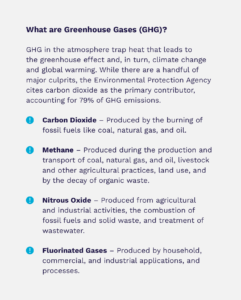Articles & Alerts
Measuring Your Carbon Footprint – The Steps to Get Started
With the intricacies of greenhouse gases (GHG), being aware of corporate emissions and your carbon footprint is now imperative. Companies not only require an understanding of the greenhouse gas definition but also need the knowledge of their organization’s emissions sources, carbon footprint measurement, data reporting guidelines, and emissions management.
What is a Carbon Footprint?
A carbon footprint simply represents the sum of the greenhouse gases produced by an entity through its activities. This carbon footprint is applicable to individuals, businesses, countries, products, and services. Recognizing one’s carbon footprint and the factors that shape it is crucial, not merely for the environmental and economic sustainability but also for regulatory compliance. Several regulatory authorities worldwide, such as the U.S. SEC and EU CSRD, mandate that businesses provide some form of GHG emissions disclosure.
Also, businesses are now more likely to be asked by their customers and partners to provide carbon footprint information, due to their legal obligations to report their emissions.
Crucial Components of Measuring Your Carbon Footprint
Enterprises emit GHG into the atmosphere just as individuals do, and both companies and individuals are expected to manage and reduce their carbon footprint. Carbon footprint management is an important component of an all-inclusive environmental, social, and governance (ESG) strategy. Although it is a time-consuming, strenuous process of meticulous assessment and monitoring, there are measures that an organization can undertake to assess its carbon footprint.
Identify GHG Emissions
GHG emissions expand outwards from a center point. In order to gauge emissions and determine precisely what to monitor, regulations called GHG scopes came into being. The various activities and sources of GHG emissions are classified into three buckets known as Scope 1, Scope 2, and Scope 3. The summation of all three scopes constitutes a company’s carbon footprint.
Emissions that result directly from the use of fossil fuels by a company-owned source, such as vehicles or boilers, are considered Scope 1 GHG emissions. These GHG emissions are simple to track and calculate. Scope 2 GHG emissions are caused by energy use that is indirectly attributed to an organization. The organization does not produce these GHG emissions onsite but rather through the purchase of electricity, steam, heating, or cooling.
Scope 3 GHG emissions result from upstream and downstream activities of an organization but not directly produced by them. These activities include transportation, distribution, corporate travel, and employee commute. Notably, the vast majority of a company’s total carbon footprint is usually comprised of Scope 3 emissions that are difficult to measure.
Measuring and managing Scope 3 emissions is a major concern for businesses, which are keenly interested in understanding the potential costs of doing so along with the long-term benefits. Regulators are grappling with the challenge of balancing the need for mandates on Scope 3 emissions, which can account for up to 75% of a company’s total emissions, with the understanding of the magnitude of the task and its impact on a company’s operations.
Use Carbon Footprint Calculation Tools and Software
A significant number of both mid-market and public companies in the U.S. face a crisis in data collection. Utilizing software specifically developed to record, track, and measure GHG inventory is the most efficient way to manage GHG emissions. Although standalone GHG calculators are useful for quick calculations, implementing comprehensive ESG and GHG emissions software is a more effective long-term solution to a sustainable ESG plan. The adoption of such a software eliminates costly data entry hours, manual calculations, and reduces the opportunities for human errors.
Calculating your carbon footprint using software has several benefits. Firstly, it ensures consistency and comparability of data, allowing you to track progress over time. Additionally, it keeps data assurance ready, while automatically splitting emissions into Scope 1, 2 and 3. Moreover, it serves as a data repository, highlighting areas of improvement. Due to the possibility of automated data collection, it also saves time and company resources.
Prepare for Reporting and Assurance
The dynamics of reporting and assuring ESG and GHG emissions are continuously evolving. As corporations, regulatory agencies, and auditors navigate through these uncharted waters, they are likely to face a shifting landscape. However, organizations should prioritize reporting and verification of their GHG emissions, even as the regulatory frameworks continue to change. Presently, there are several global standards for reporting and verification, including the recent entry of the SEC into the mix. Examples of reporting GHG emissions standards:
Many organizations haven’t chosen to select the most suitable reporting framework for their needs. The Taskforce on Climate-related Financial Disclosures (TCFD) framework offers a prime example, being a leading choice for climate-related disclosures and serving as a model for SEC reporting requirements. The GHG inventory report produced should be ready for assurance, which can be given by an auditor, engineer, or consulting firm.
Set Emissions Goals and Targets
Another essential step is to establish reduction targets and objectives. Using reporting software, companies can identify areas in their carbon footprint that require emissions reduction action. For this purpose, SBTI and RE100 offer excellent resources and initiatives to help businesses reduce their carbon footprint or ultimately achieve carbon neutrality. While there may be challenges when estimating a carbon footprint, it is important to set feasible goals that your organization can accomplish with relation to GHG emissions. As the process can take several months, having a network of supportive advisors and environmental organizations can provide much-needed encouragement on the road to sustainability.
As the U.S. continues to refine its policies and regulations regarding GHG emissions, companies must understand their carbon footprint. Anchin’s Sustainability and ESG services team can help guide you through these changes and ensure your goals are met. Contact our team today and take the first step towards measuring your GHG emissions.



